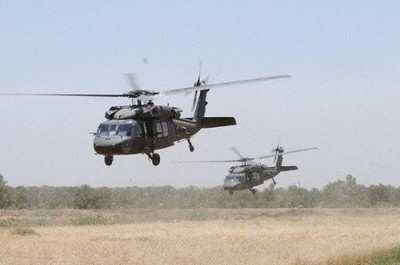Equipped With a Stronger Engine, A Digital Cockpit And
Composite Rotor Blades
The Army's new high-tech UH-60 Black Hawk M-model helicopter --
equipped with a stronger engine, a digital cockpit and composite
rotor blades -- performed exceptionally well in Afghanistan during
its first major combat deployment, according to a recently
completed After Action Review at Fort Campbell, KY, service
officials said.

"The M-model Black Hawks were in Afghanistan for 12 months. The
aircraft performed exceptionally well," said Lt. Col. Jerry Davis,
product manager for UH-60 Modernization. "We got great reaction
from pilots. They experienced a higher than average operational
readiness rate with those aircraft in theater and they loved the
technologies on-board." The year-long deployment was the first for
the M-model Black Hawks, which entered full-rate production in
June, 2007. So far, 154 M-models have been delivered, Davis
said.
The M-model Black Hawk's digital cockpit display made a large
difference with pilots, the AAR found. "We went from analogue type
displays on the dash to multifunction digital displays. Now, the
aircraft has a moving map capability with digital situational
awareness on the dash integrated with the flight plan. It gave
pilots a greater awareness of where their units were, where their
supportive units were and where the enemy locations were," Davis
said. "It has an integrated Blue Force Tracker which automatically
displays situational awareness on the moving map display, giving
greater awareness to the pilot conducting the missions."
The M--model aircraft is also interoperable with the latest Army
Aviation Mission Planning Systems - enabling pilots to plan a
mission in their pilot ready room on laptop computers, store data
onto a small card and plug it into the aircraft, allowing them to
pull up maps, graphic displays and other mission-essential
information, Davis said.
"The aircraft has a data-transfer system. Once they plug that
card in they can pull that data up on those maps and it will
display graphics as well as program their radios. You get routes,
landing locations, radio frequencies that you need to be on as well
as locations of refuel and re-arm points. All of the normal mission
planning data that a pilot has can now be done on the Aviation
Mission Planning System and transferred electronically to the
aircraft itself," Davis added.

Also, the combination of wide-chord composite rotor blades and a
more powerful engine give the M-model Black Hawk about 500 pounds
of additional lift capability compared to previous models, he said.
"The UH-60 M comes off the line with the latest GE engine that we
are using, the 701D model which has more shaft horsepower. It is a
more powerful engine," Davis said. "It is a common engine between
the Black Hawk and Apache fleets which is something very good for
the aviation logistical community."
The existing 701C --commonly used as the standard engine for
Black Hawks and Apaches for the last 15 years -- has a 1,900 shaft
horsepower engine, said Mac Dinning, aircraft survivability team
lead, Aviation and Missile Research, Development and Engineering
Center. "The 701D engine brings that up to 2,000 shaft horsepower,
giving you and extra 100 horsepower. That is a five percent
increase," he said.
 ANN's Daily Aero-Linx (05.02.24)
ANN's Daily Aero-Linx (05.02.24) ANN's Daily Aero-Term (05.02.24): Touchdown Zone Lighting
ANN's Daily Aero-Term (05.02.24): Touchdown Zone Lighting Aero-News: Quote of the Day (05.02.24)
Aero-News: Quote of the Day (05.02.24) ANN FAQ: Contributing To Aero-TV
ANN FAQ: Contributing To Aero-TV NTSB Final Report: Cirrus Design Corp SR20
NTSB Final Report: Cirrus Design Corp SR20




